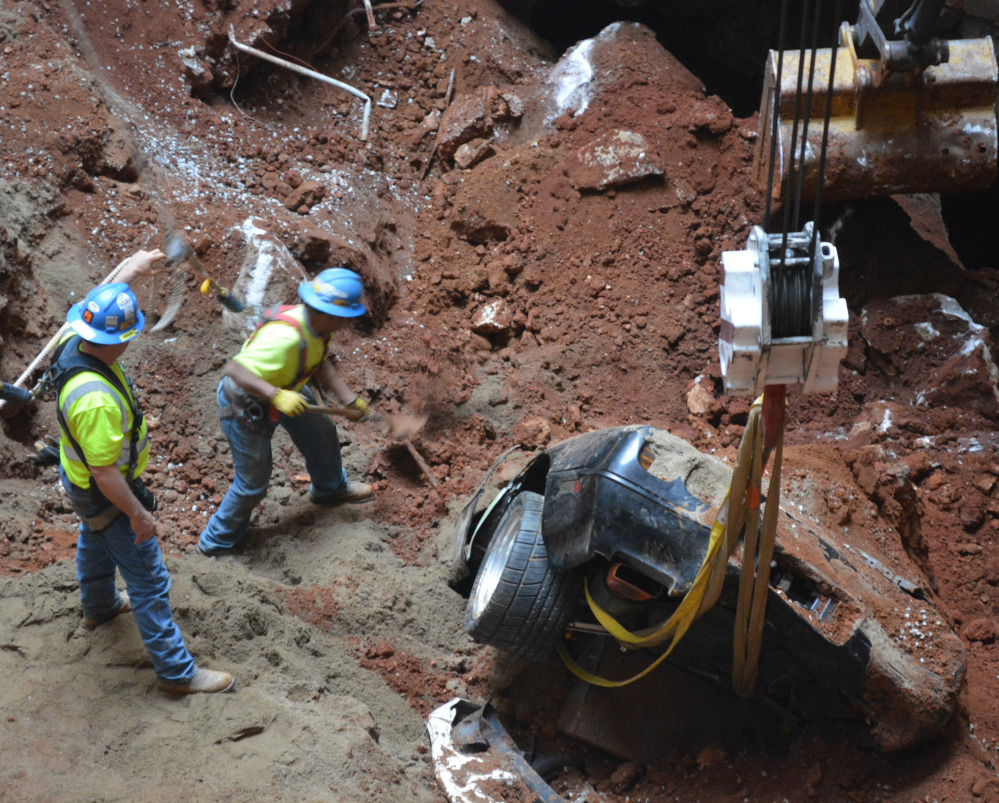A massive sinkhole that swallowed eight prized sports cars won’t be a permanent attraction at the National Corvette Museum in Kentucky.
The museum’s board of directors voted Saturday to fill in the entire hole that opened up in February and became an Internet sensation. Curiosity over the hole revved up attendance and revenue for the museum in Bowling Green, an hour north of Nashville, Tennessee.
Board members reversed course by deciding against preserving a section of the gaping hole.
Mindful of the hole’s popularity, museum officials in late June were leaning toward keeping part of the hole open and putting a crumpled sports car back in it to memorialize what happened when cars toppled like toys amid rocks, concrete and dirt when the sinkhole opened up in the museum’s Skydome.
The option of keeping part of the hole open lost favor because of added costs due to safety features, museum officials said.
“We really wanted to preserve a portion of the hole so that guests for years to come could see a little bit of what it was like, but after receiving more detailed pricing, the cost outweighs the benefit,” said museum Executive Director Wendell Strode.
To keep part of the hole, workers would have installed 35-foot-tall retaining walls and inserted beams in the hole to prevent future cracking, said museum spokeswoman Katie Frassinelli. Costs mounted to about $1 million – double earlier estimates – due to safety and humidity-control features. Another worry was ongoing maintenance costs if a section of the hole stayed open, they said.
The museum didn’t disclose how much it will cost to fill in the 60-foot-long, 45-foot-wide, 30-foot-deep sinkhole. Repairs are expected to start in November and take about six months, officials said. The museum will remain open, but the Skydome will be sealed off from visitors, who will be able to watch the repairs through a Plexiglas wall.
The hole will be filled completely with rock, then workers will drill into it to install steel casings, Frassinelli said. Crews will pour grout into the casings, creating a steel and concrete pillar to provide additional support under the floor.
Bowling Green, in south-central Kentucky, sits in the midst of a large karst region where many of Kentucky’s longest and deepest caves run underground. A karst region displays distinctive surface features, including sinkholes.
No one disputed the bonanza the Corvette Museum reaped from the sinkhole as more people ventured off the nearby interstate to visit.
Security camera footage showing the floor’s collapse has been viewed nearly 8.3 million times on YouTube, the museum said.
The Corvettes were pulled out of the hole to great fanfare. Visitors have been able to take a close look at the hole and the damaged cars.
Attendance surged by 66 percent since the hole opened up and revenue shot up 71 percent, Frassinelli said.
Museum membership has increased, and sales of merchandise are up at the museum, she said. The museum sells sinkhole-related shirts, postcards, prints and a 39-minute DVD about the sinkhole.
Meanwhile, the museum and Chevrolet have decided to repair three of the damaged cars.
Chevrolet will restore the 1992 white 1 millionth Corvette and the 2009 ZR1 Blue Devil, which was the first car pulled from the hole. Chevrolet will fund restoration of a 1962 black Corvette, but the museum will oversee the work. The other five were too badly damaged but will be displayed in their dented and crushed conditions at the museum.
“As the cars were recovered, it became clear that restoration would be impractical because so little was left to repair,” said General Motors global product development chief Mark Reuss.
Send questions/comments to the editors.



Success. Please wait for the page to reload. If the page does not reload within 5 seconds, please refresh the page.
Enter your email and password to access comments.
Hi, to comment on stories you must . This profile is in addition to your subscription and website login.
Already have a commenting profile? .
Invalid username/password.
Please check your email to confirm and complete your registration.
Only subscribers are eligible to post comments. Please subscribe or login first for digital access. Here’s why.
Use the form below to reset your password. When you've submitted your account email, we will send an email with a reset code.